Your cart is currently empty!
The Advantages of Using Synthetic Rugs for Allergy Sufferers: Low Maintenance and Hypoallergenic Benefits

As someone who suffers from allergies, I know the importance of maintaining a clean living space, especially when it comes to flooring. Rugs can be a significant source of allergens, trapping dust, pollen, and pet dander. In this context, synthetic rugs present a practical solution for allergy sufferers. Unlike wool or feathered options that can harbor allergens, synthetic rugs often resist these irritants. The smooth fibers and tight weave of synthetic materials, such as polyester or nylon, prevent allergens from embedding themselves deep within the rug, making them more accessible for vacuuming and cleaning.
The suitability of synthetic rugs for allergy sufferers is notably due to the hypoallergenic properties some of them possess. These rugs can limit the growth of dust mites and mildew, common triggers for allergic reactions. Additionally, synthetic rugs are available in low-pile varieties, which are easier to keep dust-free compared to high-pile carpets. The exploration of the hypoallergenic characteristics of synthetic rugs reveals that maintaining a healthier indoor environment doesn’t mean compromising on style and design; numerous options exist to suit diverse aesthetic preferences while keeping allergen exposure to a minimum.
Key Takeaways
- Synthetic rugs are practical for those with allergies as they can resist common allergens.
- Hypoallergenic properties of synthetic fibers contribute to a healthier indoor environment.
- Synthetic rugs provide style flexibility without increasing exposure to allergens.
Understanding Allergies and Their Triggers
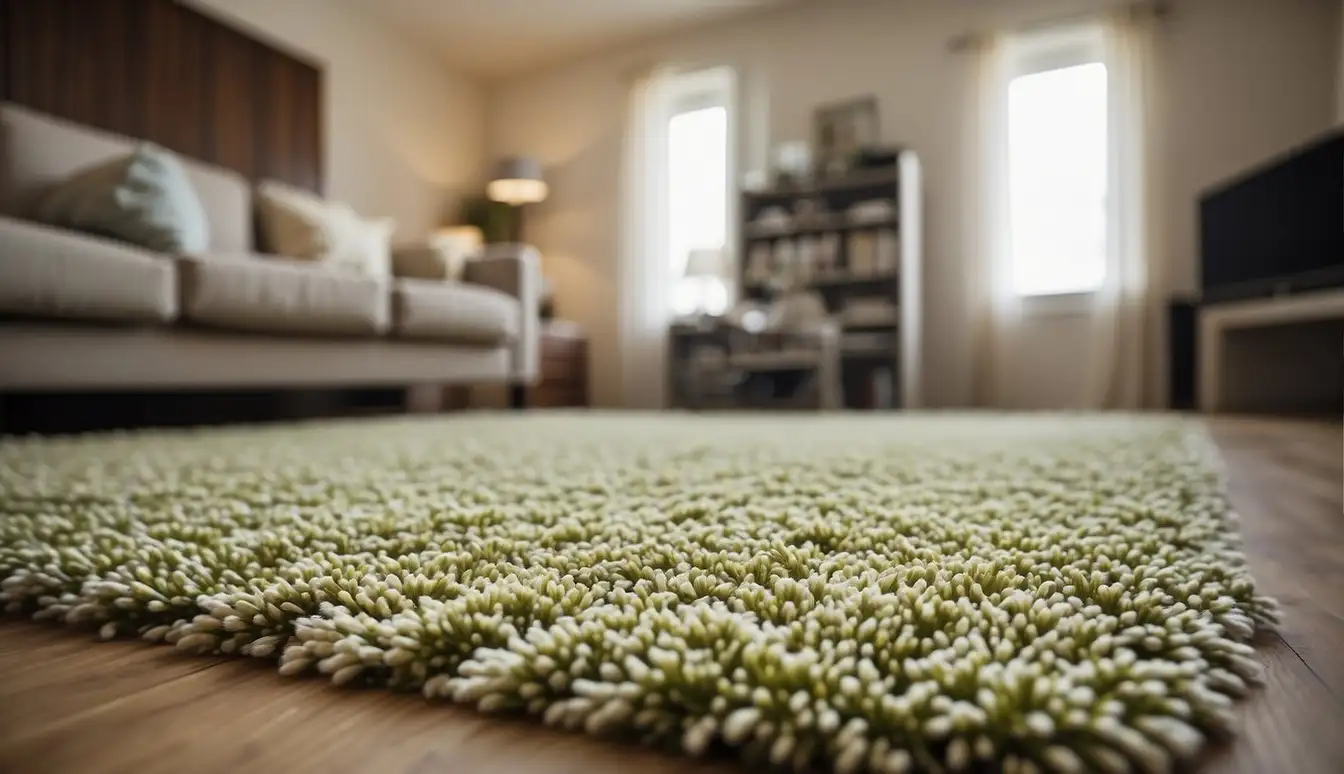
As someone who navigates through daily life with allergies, I know that understanding what triggers an allergic reaction is crucial for maintaining a comfortable home environment.
Common Allergens in the Home
In our homes, allergens are often the invisible culprits contributing to discomfort. Here’s a rundown of common household allergens:
- Dust Mites: Tiny creatures thriving in warm and humid environments. They are a leading cause of allergic reactions.
- Pet Dander: Flakes of skin shed by cats, dogs, and other furry or feathered pets, which can aggravate allergy symptoms.
- Mold and Pollen: Fungi that flourish in damp conditions and tiny particles released by plants can both cause seasonal and perennial allergies.
- Bacteria: Microscopic organisms that can coexist with mold, increasing indoor air pollution.
- Volatile Organic Compounds (VOCs): Chemicals released from paints, cleaning supplies, and even some synthetic rugs may trigger allergies or asthma.
Reducing the presence of these allergens by maintaining a clean home, using air purifiers, and choosing furnishings wisely can significantly improve air quality.
Allergies and Asthma
I’ve learned that asthma and allergies are often interlinked. Allergens like dust, mold, and pet dander can prompt an asthma attack in sensitive individuals. Other factors include:
- Dust Concentration: High levels of dust can exacerbate asthma symptoms.
- Air Quality: Poor indoor air quality might increase the likelihood of asthma attacks.
- Allergic Reactions: For people like me with allergic asthma, inhaling allergens can cause airways to swell and make breathing difficult.
Managing asthma and allergies hinges on reducing exposure to these triggers, with strategies such as using hypoallergenic rugs that resist dust mites and other allergens, thereby helping to maintain a healthier indoor environment.
Benefits of Synthetic Rugs for Allergy Sufferers
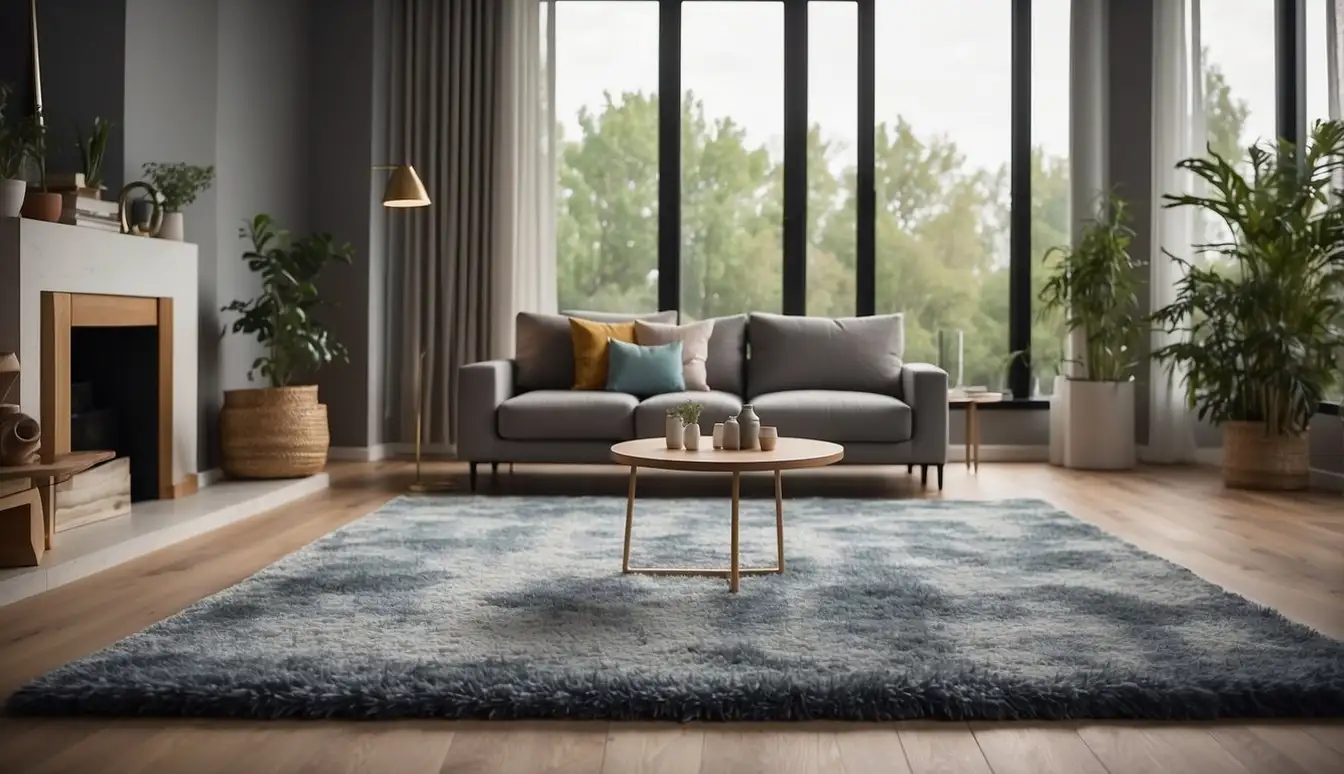
As someone concerned with maintaining an allergen-free home, I have found synthetic rugs to be a practical and effective solution for allergy sufferers. These rugs offer hypoallergenic properties and are easy to clean, making them an ideal choice for homes where air quality is paramount.
Hypoallergenic Properties of Synthetic Rugs
Synthetic materials, such as polypropylene, are engineered to be inhospitable to dust mites, pet dander, and bacteria—common irritants for those with allergies. The fibers used in these rugs are non-porous, meaning they don’t trap allergens as natural fibers can. Choosing a synthetic rug for your home provides a surface that’s less likely to harbor allergens, thus contributing to cleaner air and less irritation for allergy sufferers. As an added benefit, many synthetic rugs are crafted with anti-bacterial properties, which further helps in creating an allergen-free environment.
Ease of Cleaning and Maintenance
Maintaining the cleanliness of a rug is critical for allergy sufferers, and one of the advantages of synthetic rugs is their ease of cleaning. Unlike some natural fiber rugs that require special care, synthetic rugs can typically be cleaned using regular vacuuming and the occasional deep clean. This makes it easier for me to keep on top of any dust or pet hair buildup. Additionally, synthetic rugs often have a short-pile construction, which is ideal because they shed less and are simpler to clean compared to high-pile, shaggy rugs that might retain more allergens. Regular rug cleaning, combined with the durable nature of synthetic fibers, helps to ensure an ongoing allergen-free space in your home.
Comparing Rug Materials
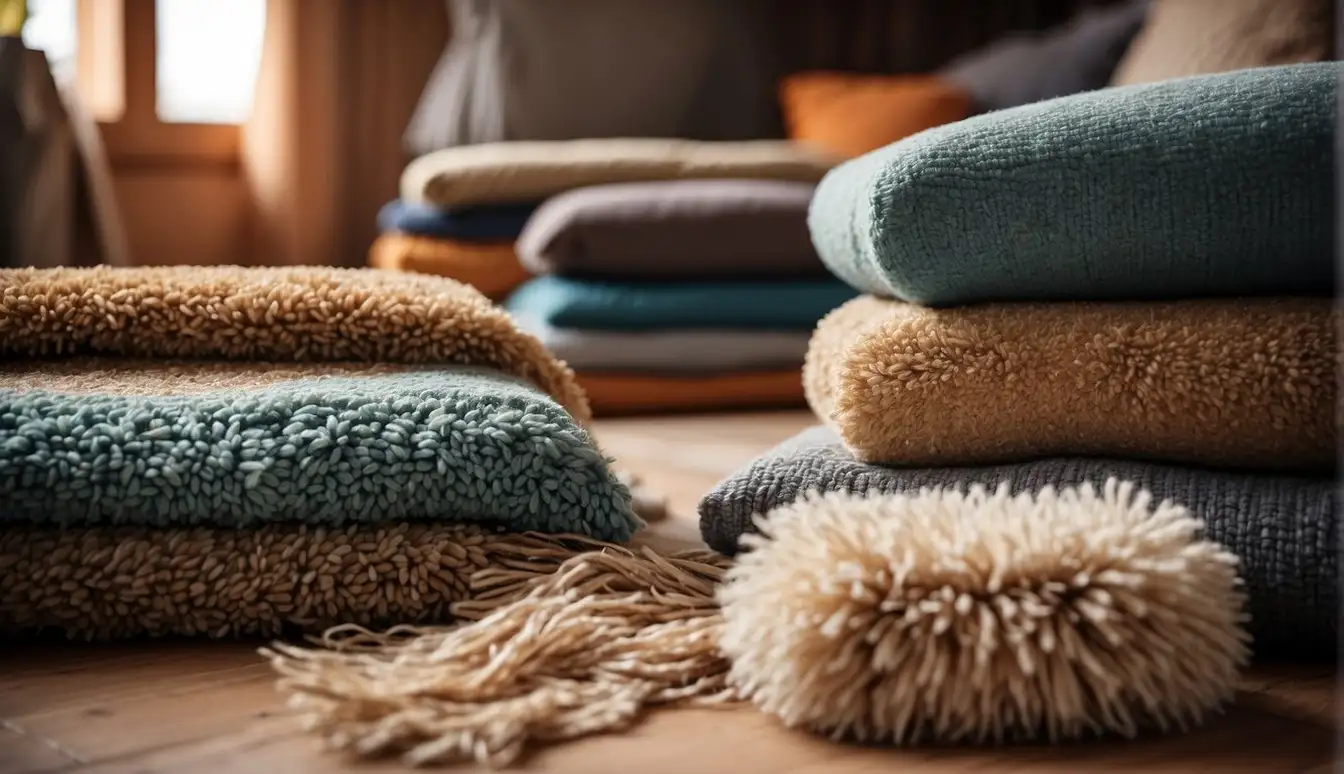
When it comes to choosing rugs, especially for those of us with allergies, understanding the difference between natural and synthetic fibers, as well as considering the pile height of the rug, is crucial to creating a healthier living space.
Natural vs Synthetic Fibers
Natural Fibers: These include materials like wool, cotton, jute, sisal, silk, and hemp. When I look for a natural fiber rug, I’m often drawn to the softness and warmth they can impart to a room. However, natural fibers can sometimes harbor allergens and dust mites more readily than their synthetic counterparts. For instance, wool rugs, although luxurious, can trigger reactions in those with a wool allergy. Sisal and seagrass are durable and have a low pile, but they may still absorb moisture and can lead to mold growth if not cared for properly.
Synthetic Fibers: Rugs made from synthetic materials such as polypropylene, nylon, and polyester are beneficial for allergy sufferers like me because they tend to repel allergens. Plus, they are often easier to clean, which helps in reducing dust and allergen accumulation. While they might not have the same natural, luxurious feel as wool or silk, the hypoallergenic qualities and ease of maintenance make them an excellent choice for homes needing a low-allergen environment.
Allergens and Rug Pile Height
High Pile: Rugs with a high pile or longer fibers, such as shag carpets, tend to trap allergens more readily. This makes them more challenging to clean effectively, which isn’t ideal for someone like me who needs to keep allergens at bay.
Low Pile: Area rugs with a low pile height are preferable for those with allergies. Low pile rugs do not trap as much dust or allergens, making them easier to clean and less likely to affect my allergy symptoms. Synthetic rugs often come with a tight weave and low pile, combining the best of both worlds—an allergen-resistant material with an easy-to-clean surface.
Design and Style Considerations
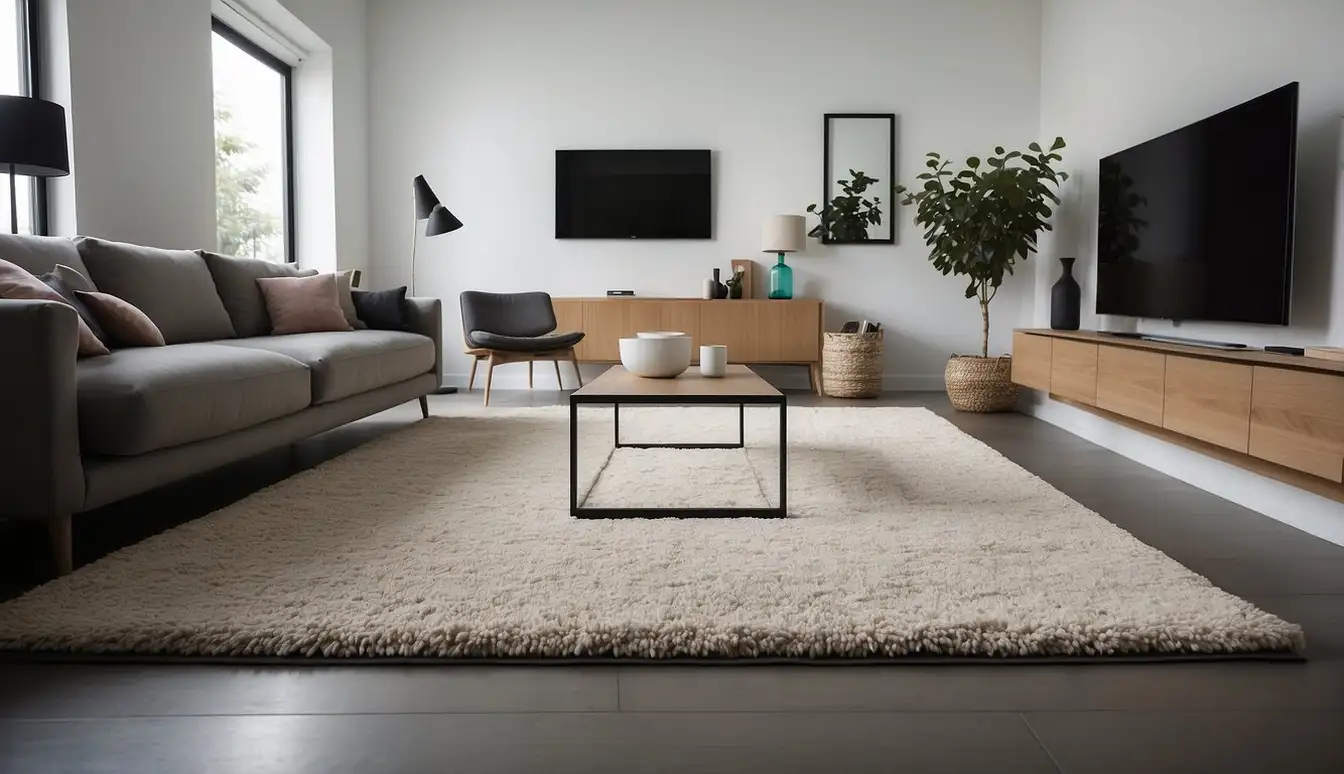
When considering synthetic rugs, I focus not only on health benefits for allergy sufferers but also on the seamless integration of style and functional design into my home. Let’s explore how to achieve that balance.
Decorating for Health and Aesthetics
Choosing a synthetic rug for its hypoallergenic properties is just the start. I make sure that my rug’s design complements my room’s aesthetics as well. For instance, I often opt for polypropylene rugs because they repel allergens and come in various patterns and colors. This allows me to maintain a stylish look while keeping health considerations at the forefront. Whether it’s a sleek modern design or a traditional pattern, I always find a synthetic rug that matches my decor preferences and supports my well-being.
Choosing the Right Rug Size and Placement
The size and placement of an area rug can greatly influence the style and design of any room. Here’s how I approach this:
-
Size: I always measure my space to ensure that I purchase a rug that fits perfectly. The rule of thumb is to pick a rug that is proportional to the area it will occupy, which often means leaving about 18 inches of bare floor around the edges of the rug.
-
Placement: Strategic placement can maximize both style and utility. In living areas, I ensure that at least the front legs of the furniture are on the rug to tie the space together. In the bedroom, I love placing a rug under the bed, extending it out so I have something plush to step onto when I wake up.
By considering both health and design when looking at synthetic area rugs, I achieve an optimal balance in my home.
Additional Tips for Allergy-Proofing Your Home
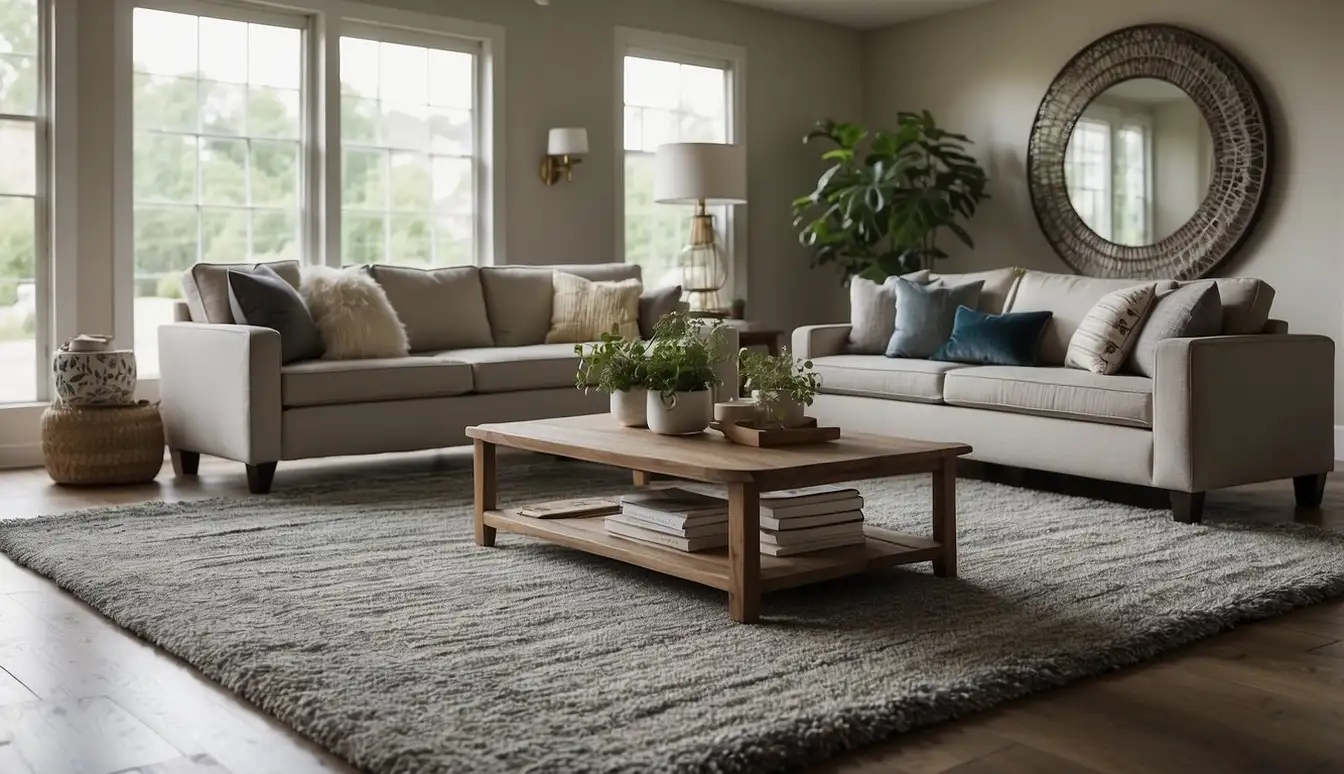
Creating a comfortable home that minimizes allergy triggers is all about attention to detail. My guide will focus on how proper vacuuming, enhanced air quality, and selecting the right finishes can make a significant difference.
Proper Vacuuming Techniques
When I vacuum, I always use a vacuum cleaner with a HEPA filter to trap tiny particles like mites, pollen, and pet dander that exacerbate dust allergies. It’s important to:
- Vacuum regularly, ideally twice a week.
- Use the right attachment for different areas: a crevice tool for edges and a brush for upholstery.
- Slow and steady passes are more effective than quick sweeps.
Enhancing Indoor Air Quality
Air quality inside my home affects how I feel, especially during allergy season. I focus on:
- Using air filters: I ensure that my HVAC system has a high-quality HEPA filter and that I replace it according to the manufacturer’s schedule.
- Natural air filters: Houseplants can be fantastic natural air purifiers.
- Limiting indoor humidity to reduce the likelihood of mold growth.
Selecting Allergy-Friendly Home Finishes
When I choose finishes for my home, I keep allergies in mind:
- Flooring: Opting for short-piled rugs or smooth surfaces like tiles can reduce dust build-up.
- Upholstery: Select materials that are easy to clean; leather or tightly woven fabrics work well.
- Cleaning products: I use baking soda for a gentle, non-irritating clean on various surfaces.
By combining these targeted strategies, I significantly reduce the presence of allergens in my home.
When to Consult a Doctor
In navigating the path to managing allergies, distinguishing between allergy symptoms and those of a common cold is crucial. It’s equally important to seek professional advice to effectively handle allergy triggers like dust, mold, and pet dander.
Identifying Allergy Symptoms vs. Common Cold
I can tell it’s time to speak with a doctor when my body’s reaction seems to align more with allergies rather than just the common cold. Here is how I differentiate between the two:
- Allergy Symptoms: Persistent sneezing, itchy or watery eyes, and a runny or stuffy nose that occur seasonally or after exposure to specific allergens like dust or pet dander.
- Common Cold Symptoms: A combination of sneezing, runny or stuffy nose, sore throat, and body aches, typically resolving within a week or two.
When my symptoms don’t improve with over-the-counter remedies or if they worsen over time, that’s my sign to reach out to healthcare professionals.
Seeking Professional Advice on Allergy Management
Discussing my symptoms with a doctor is vital when:
- I experience them for an extended period, and they interfere with my daily life.
- I suspect specific triggers like mold or wool are causing allergic reactions.
My doctor can conduct allergy tests to confirm what I’m allergic to and recommend appropriate treatment options. They may also suggest an environmental control plan, which could include switching to synthetic rugs, to minimize exposure to allergens. This proactive approach helps me handle my allergy symptoms more effectively.
Frequently Asked Questions

In this section, I’ll address some common queries regarding the use of synthetic rugs for those with allergies and asthma. These answers aim to guide you to make an informed decision that could improve your indoor living environment.
Which rug materials are most suitable for individuals with allergies and asthma?
For those with allergies or asthma, synthetic materials like polypropylene (also known as nylon) rugs are recommended. They have a natural resistance to allergens, don’t retain moisture, and inhibit the growth of mold and dust mites.
How do hypoallergenic rugs benefit allergy sufferers?
Hypoallergenic rugs are specially designed to repel common allergens such as dust, pet dander, and pollen, thereby reducing the likelihood of allergy flare-ups. The tight weave and synthetic fibers help prevent allergens from becoming lodged in the rug.
Can polypropylene rugs alleviate allergy symptoms?
Yes, polypropylene rugs can help alleviate allergy symptoms as they are made from synthetic fiber that is less likely to attract and retain allergens compared to natural fibers. Their moisture resistance also prevents the growth of mold and mildew, which are common allergy triggers.
Why are washable rugs a good option for those with dust mite allergies?
Washable rugs are excellent for people with dust mite allergies as they can be regularly cleaned to remove dust mites and other allergens. Regular washing in hot water ensures these rugs maintain a low level of allergens, making them a healthier choice for allergy-prone individuals.
What should be considered when choosing a hypoallergenic rug for a bedroom?
When selecting a hypoallergenic rug for a bedroom, consider a low-pile or flatweave synthetic rug which is easier to clean and less likely to trap allergens. Additionally, choosing a rug with an integrated non-slip backing eliminates the need for an underlay, which can also harbor allergens.
Are polyester rugs hypoallergenic, and can they affect allergy sufferers?
Polyester rugs are indeed hypoallergenic and a suitable option for allergy sufferers. These rugs are less likely to shed and don’t hold onto allergens as much as natural fibers, making them an effective choice for reducing allergy symptoms in the home.
